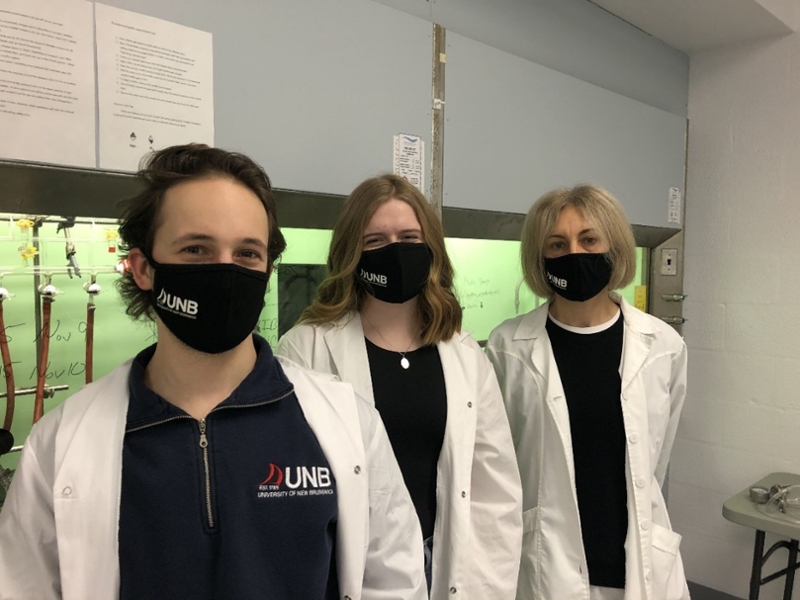UNB researchers look to special sensors to reduce risk of bioterrorism
Author: UNB Research
Posted on Apr 6, 2021
Category: Research , COVID-19 , Publications

University of New Brunswick researchers Connor O’Brien, Kathleen Varty, and Dr. Anna Ignaszak, have published an article in Nature examining the use of specialized sensors to detect highly contagious diseases and biological weapons. With the current global pandemic highlighting the rapid spread and significant impact of disease, the researchers wanted to present a wide array of electrochemical methods and platforms for the detection of the globe's most impactful diseases.
The researchers focused on pathogens categorized as Class A bioterrorism agents as these pose the greatest risk to public health. These agents can spread quickly from person to person, result in high mortality rates, cause public panic and disruption, and require special action for public health preparedness.
Although bioweapon use is rare today, a report released by the World Health Organization indicated that even a small attack could lead to illness or death for thousands of individuals. With this ability to cause mass panic, disruption, illness and death, the intentional spread of an infectious agent is a major concern for global security, health, and economy.
Electrochemical sensors work by measuring changes in electrical parameters, such as charge, voltage and impedance (a form of resistance), with an electrode or membrane. Each of these changes can be attributed to the chemical reactions occurring at the test surface, and so by specifically targeting particular reactions, we can detect the presence of a surface.
Electrochemical sensors are often rapid, portable, and cost-effective, which makes them an effective platform for identifying bioweapons and other virulent diseases in both point-of-care and environmental cases. Rapid diagnosis generally results in quicker action, and better outcomes for the patient.
The researchers hope to leverage this knowledge to prototype sensors that can deliver results within minutes, be operated by non-professional personnel, and have the ability to distinguish between target and non-target molecules.
“If we can detect each of these pathogens before they reach a community, thousands of lives could be saved, and we could better prevent the uncontrollable spread of disease. Furthermore, by highlighting some point of care detection methods, we hope to display the powerful potential of electrochemical sensing to the medical community,” said Mr. O’Brien.
The team was also surprised that only a few sensing platforms exist for detecting viral hemorrhagic fevers (VHFs). According to the researchers, as global temperatures continue to increase, so does the potential for VHFs to be transmitted. These illnesses, which include Ebola, Dengue fever and Marburg, often have no known cures and a high rate of mortality. Because of this, the authors call for special attention from the scientific community to propose and develop effective sensing platforms to reduce the risk and impact of these diseases.
Dr. Ignaszak also highlighted the strong collaboration between members of her team and how it was able to translate into their publication.
“This publication is proof of our team’s compatibility and effective collaboration. The process has been so encouraging and rewarding. I'm so happy to see that young scientists like Kathleen, a third-year student, and Connor, a new master’s student, are delivering the calibre of work that is expected from more experienced researchers,” said Dr. Ignaszak.
Want to read the full paper? Access it online here: https://doi.org/10.1038/s41378-021-00242-5
About the researchers:
Dr. Anna Ignaszak
Dr. Ignaszak came to UNB in 2015, after graduating with an MSc and PhD in Poland, working in the area of ionic conductors and sensors. She completed her postdoctoral fellowship at the University of British Columbia and with the National Research Council in Vancouver, working on projects related to electrocatalysis and fuel cells, and collaborating with world-leading companies like Ballard Power Systems. Since 2012, she obtained a Junior faculty position at the Friedrich-Schiller University in Jena and continued developing new materials with improved functions for energy storage, flexible electronics, and electrochemical sensors. Dr. Ignazsak is an associate professor in the department of chemistry.
Connor O’Brien
Connor is a master’s student at the University of New Brunswick in the department of chemistry, and a 2020 BSc. graduate of UNB with first class honours in Medicinal Chemistry. He is the former Events Coordinator and President of the Undergraduate Chemistry Society, where he led the growth of society membership and community involvement to an all-time high. He is interested in electrochemical techniques for application towards medical research. This interest has led to a featured article on electrochemical cancer treatments, and now towards becoming a Nature published author. His interest in health has extended into the community by way of the Canada East Spine Centre and in his work developing UNB’s first graduate peer led support group. His current research focuses on the development of organic supercapacitor species through green and low-toxicity processes.
Kathleen Varty
Kathleen is a third-year biology-chemistry undergraduate student at UNB, Fredericton. At UNB she , workings in both the biology and chemistry departments on its Fredericton campus, and is currently working with the Ignaszak Group on a variety of electrochemical techniques. During the summer, she is a student technician with the Canadian Rivers Institute where she assists in river ecosystem studies. She is interested in translational medicine research and plans to follow this passion into a master’s program. Her interest in medicine has led her to be an active volunteer with the Canadian East Spine Center.
More information:
Dr. Anna Ignaszak | Department of Chemistry, Fredericton
Research at UNB | Graduate Studies at UNB | Postdoctoral fellowships